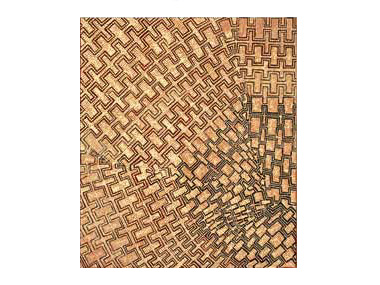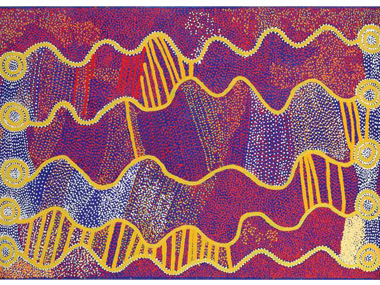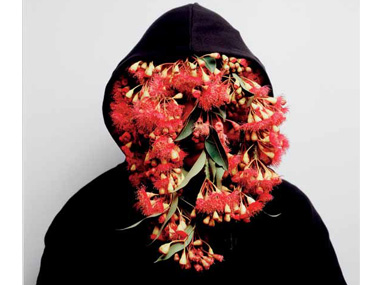Crossing Cultures in the US

Danny Gibson Tjapaltjarri, Pintupi, born 1976. 'Mukula' 2009, 107 x 91 cms, Acrylic on canvas
Posted by Jeremy Eccles | 21.09.12
Dates:
15.09.12
: 14.07.13
Location: Hood Museum, Dartmouth College, New Hampshire
America is having a far better year than Australia in terms of its experience and appreciation of our Indigenous art. First there was the Kaplan/Levi Collection on show in the Seattle Art Museum; now, across the country in New Hampshire, the Owen/Wagner Collection has just opened at the Hood Museum of Art in Dartmouth College, accompanied by a series of talks from curators, academics and Blak artists running through October. Both have been accompanied by concurrent commercial shows from the likes of Papunya Tula Artists and Coo-ee Gallery. And everywhere else you look – particularly at the Kluge Collection in Virgina – there seems to be shows of urban Aboriginal art – though fortunately, its reception in the US seems to be largely within the Euro-American historical continuum, a place that's much harder to achieve here.
The Hood was the Museum that offered a home to Irishman, Brian Kennedy after he left the National Gallery of Australia; and he introduced the 18th Century institution to 'Contemporary Aboriginal Australian Art' as they quirkily call it.
Both American institutions have published substantial catalogues; the Hood calling in Kennedy, ex-NGV/now-Hood Indigenous curator Stephen Gilchrist, Howard Morphy, John Carty Francoise Dussart and others. And, if the Seattle experience is anything to go by, it attracted significant press coverage of the sort that hasn't been see in the States since the great 'Dreamings' exhibition at the Asia Society in New York in 1988.
Which is where Will Owen and Harvey Wagner came in. The NY couple had been collecting US minimalists and colour field artists, but were finding the 80s a pretty fallow time. But, open to Abstraction, they discovered its apparent Aboriginal version “a life-changing experience”. Will Owen – who went on to pen the surprisingly influential website, 'Aboriginal Art & Culture : An American Eye' from 2005 – also recalls in his catalogue essay that they saw “no representation, but canvases full of incident”. And barks employing “ochres, dazzled like the face of a seething dark star”. Life-changing indeed!
Two years of 'simmering' later, they came to Oz, visited some galleries, and went home with a single, probably touristic work by the unheard-of Wayne Bright Tjangala! It was the unlikely beginning of an addiction that involved commissioning artists, visiting 24 remote art centres on an Australian Trade Commission-sponsored trip, discovering Arnhemlend art through John Mawurndjul's genius, and even coming to terms with urban art, inspired it would seem by their disquiet over John Howard's Intervention in 2007. Indeed, the subtitle of the show at Hood is: “How Aboriginal Artists Have Reinvigorated Vernacular Iconographies and Traditions through a Modern Lens in More Than 100 Contemporary Works”.
Which comes down to the following: “While the exhibition features many influential artists who have contributed to the development of an Indigenous art canon since the 1970s, the focus is squarely on subsequent generations of artists, who are breathing new life into ancient stories and broadening the possibilities of Indigenous art.”.
“You don't have to understand the details of a painting's story”, says Owen; “but you do have to appreciate the centrality of the principles (of it) to the artist to understand how they pour the energy of life into their canvases”. And he's picked four key works from Gilchrist's selection to amplify this key understanding – none of which is available as an image unfortunately. There's a 1974 Uta Uta Tjangala work, 'Kungka Kutjarra' (Two Girls), a fine Tingari Story from the era when Papunya Tula artists were first restricting themselves to this open material. Yinimal Gumana supplies a Yolgnu bark, 'Motu', capturing the meeting place of fresh and sea water. The early Paddy Bedford work, 'Emu Dreaming at Mt King' reveals how well connected Owen and Wagner were by 1999 – getting a piece of the East Kimberley master before he was widely known. And Clinton Nain's 'and the blak mother crys' is a tough piece of urban art.
Stephen Gilchrist is at his best in the catalogue commenting on the small proportion of urban art. “As insignia of Australia, our gums are used on the coat of arms, as emblems of states and territories, and to celebrate the centenary of Federation. Christian Thompson’s photographs, however refuse to be co-opted as colonial trophies, and rearticulate the flowers’ central associations with Indigenous ways of caring for the land”. Good stuff!
Following its appearance at the Hood, Crossing Cultures will be on view at the Toledo (Ohio) Museum of Art from April 11 through July 14, 2013.
URL: http://hoodmuseum.dartmouth.edu
Share this:
»  del.icio.us
»
del.icio.us
»  Digg it
»
Digg it
»  reddit
»
reddit
»  Google
»
Google
»  StumbleUpon
»
StumbleUpon
»  Technorati
»
Technorati
»  Facebook
Facebook
Contact Details

Shorty Jangala Robertson, Warlpiri, born about 1935, 'Ngapa Jukurrpa—Puyurru' (Water Dreaming at Puyurru), 2007, acrylic on canvas.

Christian Thompson, Bidjara, born 1978, 'Black Gum #2', 2007, C-type print, ed. 1/10. © Courtesy of the artist and Gallery Gabrielle Pizzi
Further Research
Artists: Clinton Nain | John Mawurndjul | Paddy Bedford | Uta Uta Tjangala | Wayne Bright Tjangala | Yinimal Gumana
News Tags: Brian Kennedy | Harvey Wagner | Hood Museum of Art | Seattle Art Museum | Stephen Gilchrist | Will Owen
News Categories: Blog | Exhibition | Feature | Industry | News | North America
Exhibition Archive
- 10.10.17 | TARNANTHI 2017
- 11.08.17 | Natsiaas 2017
- 20.07.17 | APY ART DOMINATES THE WYNNE
- 17.07.17 | Anangu Artist Wins $100,000 Prize
- 14.07.17 | The End of AAMU
- 11.07.17 | ART ACROSS THE COUNTRY
- 11.07.17 | TARNANTHI IN OCTOBER
- 05.07.17 | TJUNGUṈUTJA - from having come together
- 13.06.17 | Ghost-Nets Straddle the World
- 07.06.17 | Grayson Perry Going Indigenous?
- 05.06.17 | Barks Bigger than Ben Hur
- 27.05.17 | NGA QUINQUENNIAL 2017
- 21.05.17 | Blak Douglas Finds Home at the NGA
- 21.05.17 | BRIAN ROBINSON WINS HAZELHURST WOP
- 18.05.17 | PARRTJIMA 2.0
Advertising

